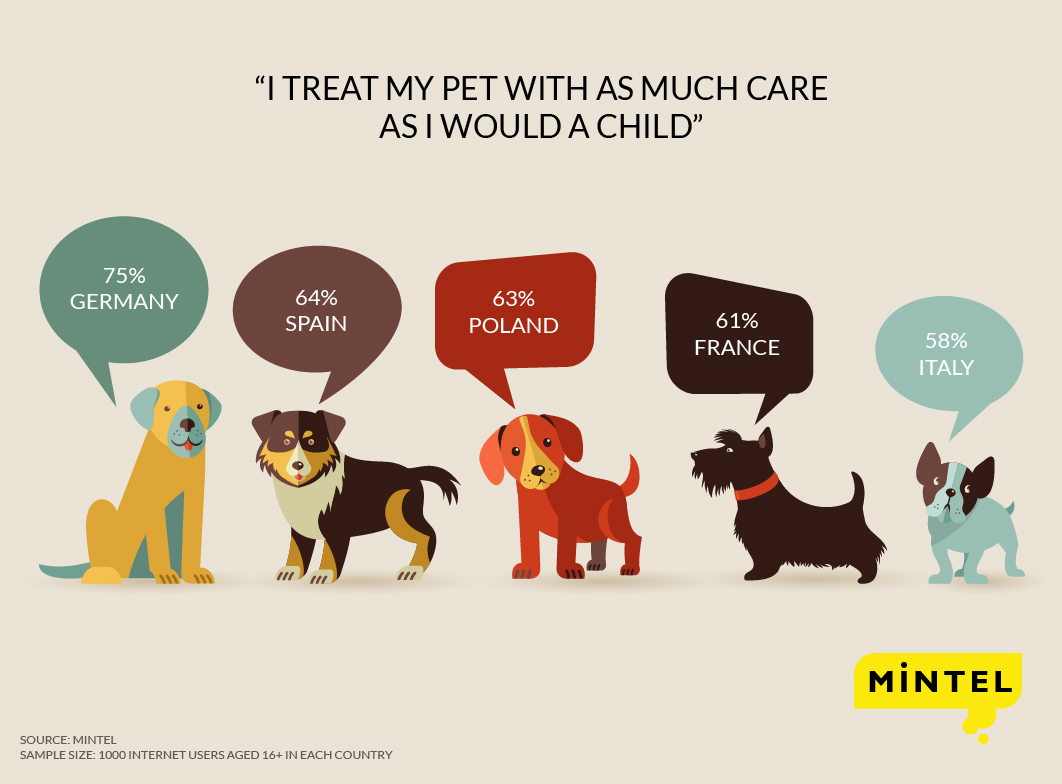Pet love: Three-quarters of German pet owners treat their pet like a child
Pets are increasingly considered members of the family across Europe, but pet love seems to be particularly strong in Germany. New research from Mintel reveals that three-quarters (75%) of German pet owners say they treat their pet with as much care as they would a child. In other European countries this number is considerably lower, with only 64% of Spanish, 63% of Polish, 61% of French and 58% of Italian pet owners saying the same.
What’s more, it seems that the phrase ‘the dogs dinner’ has recently been redefined with seven out of ten (69%) German consumers who own pets agreeing they expect the same quality standards from the food they choose for their pet as their own food. And this attitude is seen throughout Europe: 67% of Italian, 65% of Spanish, 63% of French and 52% of Polish pet owners say they expect the same quality standards from the food they choose for their pet as their own food.
Katya Witham, Senior Food & Drink Analyst at Mintel, says:
“Declining birthrates, the rise of one-person households and growing rates of divorce all contribute to the rise in the status of pets in Germany and other European markets. Pets have become a substitute for human companionship, with pet owners treating their pets like a family member or even like children.”
With pet humanisation on the rise, more consumers are demanding pet food that goes beyond providing adequate nutrition. As Mintel research shows, almost three-quarters (73%) of German pet owners say it is important to offer variety in their pets’ diet, while more than three in five (64%) say they would like to see more all natural pet foods.
Additionally, two out of five (38%) Germans who own pets would welcome more allergen-free pet food varieties, such as dairy-free or gluten-free options, while the same percentage (38%) would like to see more low-fat or low-sugar pet treats.
In response, manufacturers of cat and dog food operating in Germany are offering more tailored and specialised pet nutrition. Accounting for 14% of all dog and cat food launches in Europe in the last 12 months ending October 2015, Germany ranks second after the UK (17%) with regards to dog and cat food innovation in Europe, well ahead of Spain (11%) and Poland (8%).
Among all the dog and cat food innovation in recent years, “natural” positioned pet foods have seen the strongest uplift, with 62% of all dog and cat food products launched in Germany in 2015* featuring a “no additives/preservatives” claim. This is almost double the number in 2013, when 33% of launches held the same claim.
“The trend towards healthy eating and a holistic lifestyle not only influences consumers’ diets, but also their choice of food for their pets. Pet food increasingly develops beyond nutrition and flavour innovation, as consumers demand health benefits, ingredient quality and manufacturing standards at the same level as for human food.” Katya adds.
According to Mintel research, the steady growth of the market value in Germany reflects the premiumization of pet food, with pet food retail sales forecast to reach close to EUR 3.16 billion in 2018, up from EUR 2.83 billion in 2014.
Moreover, Mintel research forecasts the German pet food market to grow at a compound annual growth rate (CAGR) of 3.2% between 2015 and 2019, compared to 2.4% in France over the same period. While the growth of the pet food market in Germany is set to outpace France, it is however still lagging behind the UK, where pet food is forecast to grow at a CAGR of 3.3% over the next four years.
But the German pet food market is not just one of the most valuable in Europe, but also the third largest in volume. In 2015, Germans are forecast to buy 1.01 million tonnes of pet food, which means only the French and Brits buy more pet food, with an expected consumption of 1.13 million tonnes and 1.10 million tonnes, respectively.
“With German pet owners becoming increasingly concerned about the health and wellbeing of their furry companions, there are opportunities arising for pet food manufacturers to further innovate and specialise. Tailoring products to address pets’ lifestyles, health issues, stages of life and levels of activity could open up potential avenues for further premiumisation.” Katya concludes.
*December 2014 – November 2015
Press review copies of the research, more information on the sample sizes of the surveys and interviews with Senior Food and Drinks Analyst Katya Witham are available on request from the press office.

Katya Witham is Senior Food & Drink Analyst, identifying and exploring the major trends across various FMCG categories, giving invaluable insights into global markets.
-
Mintel StoreGet smart fast with our exclusive market research reports, delivering the latest data, innovation, trends and strategic recommendations....View reports
-
Mintel LeapMintel Leap is a revolutionary new AI-powered platform that will transform your research process....Book a demo








































